CORRECTION: ST Kinetics informs us that the 40-mm munition is not technically a mortar round. It has a smaller caliber than a mortar.
Long a staple of the infantry unit, the 40-millimeter round comes in many shapes and functions: low and high velocity, training, green, non lethal, and whatnot. The large volume of the round itself has prompted a manufacturer to think outside the box and consider this popular standard as a projectile with a payload.
ST Kinetics, a defense subsidiary of the Singapore Technologies conglomerate, has devised a couple of interesting tricks. The coolest gimmick ST Kinetics pulled is with a round called SPARCS, or Soldier Parachute Aerial Reconnaissance Camera System. The round will usually climb 150 meters and travel down range about that same distance, then deploy a small camera that gently falls from the sky via parachute while transmitting images to a ground unit. The photos are are then stitched into a bigger and higher resolution version that can be shared and zoomed.
It's the kind of thing a drone is usually called in for, but a mortar round is smaller, more expendable, and does the job with an immediacy that's hard to match.
The video feeds the rounds send out, which are encoded using the phase alternating line scheme, are not encrypted. Encryption is not needed because the rounds don’t store any information and the images they transmit are of little strategic value to the enemy. “As an enemy, if you intercept it, so be it: it’s your area!" says an ST Kinetics spokesperson.
A portable base station—compatible with a wide range of military and consumer devices, including those running Android—receives the signal.
This is hardly the only example of electronics-enhanced munitions. Most 40-mm rounds are set off by impact, but there are also those designed to burst in air at time programmed while the round is in the rifle. The programming device contains a laser-ranger; a soldier measures the distance to the target and decides if how close it should go off. The system then converts distance into time and assigns it to the round. All this happens rather quickly and can be rather useful if, for example, a soldier needs to fire at an enemy hiding behind cover, which the round would be unable to penetrate. Even soldiers behind a tank or hiding behind a building are then fair game.
Smart munitions of this type seem to be good business: ST Kinetics says it secured more than US $30 million in orders in 2013 alone. Some of those orders went to the U.K. and Canada, but the big fish is the United States. The U.S. Army has decided to test the air-burst round, according to the company.



